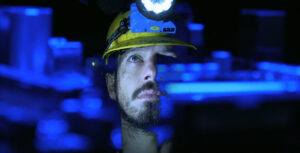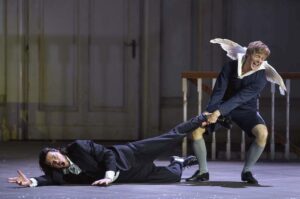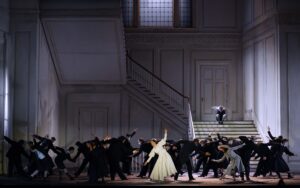As Javier Marías once said, Madrid seems to be in a hurry to say everything. My visits to the Spanish capital have always been very brief. This time I spent nearly a week there, in the company of friends who know the city inside out – and yet Madrid kept nudging me, showed me unknown backstreets, had me lost in the crowd at El Rastro, gorge on snails in a thick broth of Spanish ham and chorizo, and absorb the fragrance of the roses in full bloom in the Retiro park. Obviously, Madrid would not have been itself, if it had not remained me even before my departure to take a look at the April repertoire of Teatro Real. In the end I chose two performances – less and more obvious – not expecting, however, that both would turn out to be a source of surprises and give me plenty of food for thought.
The Catalan ensemble Agrupación Señor Serrano, which combines in its productions elements of performance, dance, video art and interactive stage actions, has appeared many times in Poland, for example at Konfrontacje Teatralne in Lublin or Kontrapunkt Festival in Szczecin. The Teatro de La Abadía, where its latest venture, Extinción, was premiered, was talked about in Poland in 2010, in connection with the premiere of Beckett’s Endgame directed by Krystian Lupa (with music by Paweł Szymański) – a production in which Hamm was played by no less a figure than José Luis Gómez, for me a memorable Luis from Saura’s Blindfolded Eyes, while younger viewers may remember his performance in Almodóvar’s The Skin I Live In. It was Gómez, who in 1995 established this theatrical laboratory, as it were – in the chapel and assembly hall of a former boarding school for girls, a complex constructed in the 1940s in the late art déco style – and still tirelessly keeps an eye on all its initiatives.
Extinción. Marcel Borràs. Photo: Teatro de La Abadía
The Señor Serrano group has for years been exploring the theme of increasing destruction of the natural environment, combined with a tragedy for humanity, inevitable in the face of this catastrophe. This time, however, the group decided to couple this vision with the music of a Catalan Benedictine monk, Joan Cererols, performed live by members of the Teatro Real chorus and instrumentalists of the Nereydas ensemble conducted by Javier Ulises Illán. The artists chose two masses by Cererols, popularised in the Iberian world by the memorable recordings of La Capella Reial de Catalunya conducted by Jordi Savall: Missa de Batalla, commemorating the victory of the Spanish army and regaining of control over Naples in 1648, after the independent Neapolitan Republic episode, which lasted less than a year; and the slightly later Missa pro defunctis, dedicated to the victims of a plague epidemic, which decimated the population of Barcelona in the 1650s.
As usual, Àlex Serrano and Pau Palacios – the director and dramaturg of Extinción – abandoned a coherent linear narrative in favour of free-flowing digressions. From the conquistador Francisco de Orellan’s expedition to find the legendary land of El Dorado to the illegal – on account of a civil war – exploitation of the Congolese deposits of coltan, this modern “gold”, needed to produce smartphones, among other things. From reflections of philosophers and physicians on the seat of the human soul to dilemmas associated with artificial intelligence. Everything intertwines and intermingles as if in a dream: a hand immersed in the black soil of the Amazon forest fishes out a mobile phone, a hand immersed in the body of a dead human releases liquid gold from his guts. Destructive fanaticism goes hand in hand with an orgy of consumerism. All these images, generated on site with the help of three performers – Carlota Grau, Marcel Borràs and Serrano himself – transformed and projected on a screen placed upstage, reminded me vaguely of Rodrigo García’s scandalising Golgota Picnic . Unlike most of my Polish colleagues I saw that production live. I was not outraged, but was left with a feeling that somebody was reinventing the wheel. I had a similar impression when watching Extinción – at times vivid, but more often getting bogged down in a chaos of confused associations, unnecessarily revealing the “behind the scenes” at the expense of the magic of the theatre. I felt that magic only in the finale, in the perverse scene of the redemption of humanity by the sacrifice of its consumeristic madness. The convulsive dance to the sounds of the Agnus Dei from Missa de Batalla (phenomenal Carlota Grau) took place in a shower of fresh popcorn pouring from hot “thuribles” hanging above the stage. Memories of Golgota Picnic were revived again: the buttery aroma of García’s buns symbolising excessive feeding of the multitude blended for me with the buttery aroma of popcorn – the incense in the twenty-first-century temple of universal excess. The metaphor may not be revelatory, but it is finally clear.
Extinción. Carlota Grau in the final scene. Photo: Teatro de La Abadía
Unfortunately, apart from this one exception theatrical actions did not go hand in hand with the narrative of Cererols’ mass. This is partly the fault of the overall concept, pushing the musicians to the background with regard to the performing artists and, above all, the performance itself. While the instrumentalists from the Nereydas ensemble were impeccable, although their subtle, stylish playing often got lost way upstage, the Teatro Real chorus members lacked either the will or the skill to get to grips with the unique idiom of the Catalan composer. Intonation was poor, there were no dynamic nuances, and the insecure and often unbeautiful singing smothered both the intricacies of the polychoral texture of Missa de Batalla and the rough asceticism of Missa pro defunctis, in which Cererols consciously alludes to the late Renaissance rhetoric of Tomás Luis de Victoria’s works.
Thus I treated Extincion as an interesting, though not fully successful performative experiment, pinning more hopes on the creative team and performers of The Marriage of Figaro on Teatro Real’s main stage. Initially, this was supposed to be the premiere of a new directorial vision of Lotte de Beer in a co-production with the Aix-en-Provence Festival, but as early as last December a decision was made to replace de Beer’s controversial and, to put it mildly, not very successful staging with a revival of Claus Guth’s notorious 2006 production. Guth’s Salzburg staging once generated extreme controversy and was treated by many critics as an attempt on Mozart’s masterpiece. Refreshed years later, it leads to the conclusion that an attempt on a sacred interpretative tradition was made at the time not so much by the director, but the conductor, Nikolaus Harnoncourt. It was Harnoncourt who, with Guth’s considerable help, extracted from the score of The Marriage of Figaro unexpected tones of grotesque and tragedy, supported by expressive acting on the part of the singers and clear, ascetic sets designed by Christian Schmidt.
The Marriage of Figaro. André Schouen (Count Almaviva), and Uli Kirsch (Angel). Photo: Javier del Real
In the Madrid production the focus again shifted a little and the whole, especially when compared with Guth’s later stagings in Vienna and Frankfurt, seemed almost like a classical approach, largely in keeping with the authors’ intentions. Only now did I appreciate the aptness of the mirror-like division of the stage space into the “downstairs” part; the “upstairs”, inaccessible to the lowly mortals, where only those closest to the count and countess were allowed; and the ambiguous mezzanine, a place of actions going beyond the convention, actions the nature of which we can only guess. Once again I was stunned with admiration at the precision of the Countess and Count’s silent quarrel to the accompaniment of the wedding march in Act 3. I was much more sympathetic this time to the introduction of the additional character of Angel (Uli Kirsch), who in Guth’s concept is not only a defeated Cupid but also an alter ego of the naïve, hormonally tormented Cherubino.
The production does have its weaknesses, but their number is small enough not to disrupt the flow of the narrative and to provoke the audience not only to reflect, but also to burst out laughing. I find Ivor Bolton’s approach to the whole more acceptable in some respects than Harnoncourt’s dark interpretation. Bolton conducts The Marriage of Figaro with an assured hand, avoids too sharp contrasts in tempi, but strongly emphasises expression instead, bringing out from the texture plenty of underappreciated details (like the splendidly accented grace notes in the bassoons and oboes in the wedding march). He is also helpful to the singers, who were truly excellent in the first cast I heard – led by Julie Fuchs (Susanna), dazzling in her acting and extraordinarily musical, a singer with an agile soprano with a beautiful silvery timbre. Marie José Moreno (Countess) was not much inferior to her in terms of the beauty of her voice, and even surpassed her with the power of expression and maturity of interpretation in the melancholic aria “Dove sono”. It’s been a long time since there were two baritones so cleverly juxtaposed in the leading male roles: one robust, impetuous, and tinged with a distinctive plebeian note (Vito Priante as Figaro), and the other noble, velvety, irresistibly seductive in his singing (André Schouen as the Count). Although Rachael Wilson’s light, silky, well-assured mezzo-soprano sounded too feminine for the trouser role of Cherubino, the singer masked this shortcoming with brilliant acting. Particularly memorable performances in the supporting roles came from Monica Baccelli, an expressive singer with an extraordinary sense of comedy, as Marcellina and Christophe Mortagne, an excellent French character tenor, as Basilio.
The Marriage of Figaro, Act 3. Photo: Javier del Real
It’s a strange feeling, travelling across the operatic world these days. Every sound, every gesture and every image is absorbed, analysed and contemplated: just in case the current journey should turn out to be the last. And then all this is described. With passion but also out of a sense of duty, because – to refer to Marías again – the world depends on its storytellers. Also the enchanted world of opera.
Translated by: Anna Kijak




